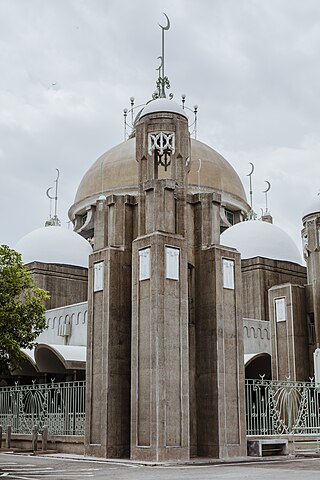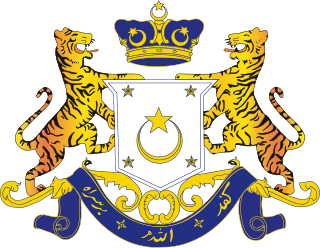Raja Permaisuri Tuanku Bainun is the former Raja Permaisuri of Perak. She was also the ninth Raja Permaisuri Agong of Malaysia and historically the first commoner ever to be installed as the Raja Permaisuri Agong. She is the widow of the late Sultan Azlan Shah and the mother of the incumbent Sultan Nazrin Shah. She is now styled as Yang Maha Mulia Raja Permaisuri Tuanku Bainun.

The Kuala Kangsar is the royal town of Perak, Malaysia. It is located at the downstream of Kangsar River where it joins the Perak River, approximately 25 km (16 mi) northwest of Ipoh, Perak's capital, and 98 km (61 mi) southeast of George Town, Penang. It is the main town in the administrative district of Kuala Kangsar, about 235 km from Kuala Lumpur, Malaysia. The town is administered by the Kuala Kangsar Municipal Council, formerly known as Kuala Kangsar District Council from 1 January 1980 until 17 February 2004.
Sultan Idris Al-Mutawakil Alallahi Shah Ibni Almarhum Sultan Iskandar Shah Kaddasullah, CMG was the 33rd Sultan of Perak from 5 January 1963 until his death on 31 January 1984. He was the son of Sultan Iskandar Shah.

The Sultan of Johor is a hereditary seat and the sovereign ruler of the Malaysian state of Johor. In the past, the sultan held absolute power over the state and was advised by a bendahara. Currently, the role of bendahara has been taken over by first minister with the constitutional monarchy system via Johor State Constitution. The sultan is the constitutional head of state of Johor. The sultan has his own independent military force, the Royal Johor Military Force. The sultan is also the Head of Islam in Johor state.
Sultan Yussuff Izzuddin Shah Ibni Almarhum Sultan Abdul Jalil Karamatullah Nasiruddin Mukhataram Shah Radziallah Hu'an-hu, KCMG was the 32nd Sultan of Perak, a state in the then Federation of Malaya.
Sultan Iskandar Shah Ibni Almarhum Sultan Idris Murshidul Azzam Shah Rahmatullah was the 30th Sultan of Perak. Perak at that time was part of the British-administered Federated Malay States. He stayed at the Istana Kenangan, then moved to the Istana Iskandariah in Bukit Chandan, Kuala Kangsar.
Sultan Abdul Jalil Karamatullah Nasiruddin Mukhataram Shah Ibni Almarhum Sultan Idris Murshidul Azzam Shah Rahmatullah KCMG was the 29th Sultan of Perak. During that period, Perak was part of the Federated Malay States.

The Sultan of Perak is one of the oldest hereditary seats among the Malay states.

Sultan Sulaiman Royal Mosque is Selangor's royal mosque, which is located in Klang, Selangor, Malaysia. It was constructed by the British in the early 1932 and was officially opened in 1933 by the late Almarhum Sultan Sir Alaeddin Sulaiman Shah.

The Ubudiah Mosque is a small mosque located in the royal town of Kuala Kangsar, Perak, Malaysia.
Raja Yong Sofia binti Almarhum Sultan Azlan Muhibbuddin Shah Al-Maghfur-lah is the fifth child of the Sultan of Perak, Sultan Azlan Shah. She holds a master's degree in Administration from International University in London. She worked for Bank Bumiputra.

Sultan Sir Idris Murshidul Azzam Shah Ibni Almarhum Raja Bendahara Alang Iskandar Marhum Teja was the 28th Sultan of Perak. Perak at that time was part of the British-administered Federated Malay States.
Iskandariah Bridge or Sultan Iskandar Bridge is one of four major bridges in Kuala Kangsar, Perak, Malaysia with the other one being the Sultan Abdul Jalil Shah Bridge. The 308 metre bridge crosses the Perak River near the town and is made out of steel.

Raja Zarith Sofiah binti Almarhum Sultan Idris Shah is the Raja Permaisuri Agong (Queen) of Malaysia and the Permaisuri (Queen) of Johor as a wife of Sultan Ibrahim ibni Almarhum Sultan Iskandar. She was born as a member of the Perak royal family. While still attending Somerville College, Oxford, she married the heir to the throne of Johor. Now a mother of six, she participates in the work of non-governmental organisations and universities, and writes a periodical column for a newspaper.

The Istana Kenangan which today houses the Perak Royal Museum, was a royal residence in Kuala Kangsar in Perak, Malaysia.

Sultan Nazrin Muizzuddin Shah ibni Almarhum Sultan Azlan Muhibbuddin Shah Al-Maghfur-Lah is the Deputy Yang di-Pertuan Agong of Malaysia since December 2016 and the 35th Sultan of Perak since ascending to the throne in May 2014.

The Al-Ghufran Royal Mausoleum is a Royal Mausoleum of Perak located near Ubudiah Mosque at Bukit Chandan in Jalan Istana, Kuala Kangsar, Malaysia. The first Sultan of Perak buried here was Sultan Idris Murshidul Azzam Shah I in 1916.

Tunku Iskandar ibni Tunku Ismail is a member of the Johor royal family and the Raja Muda of Johor. He is the first son and second child of the current Tunku Mahkota of Johor, Tunku Ismail ibni Sultan Ibrahim and his consort, Che’ Puan Mahkota Khaleeda binti Bustamam. As his father is the heir apparent, upon his birth, Tunku Iskandar becomes second in line of succession to the throne of Johor.
Raja Iskandar Dzurkarnain ibni Almarhum Sultan Idris A’fifullah Shah is the Raja Di-Hilir of Perak and the second in the line of succession to the throne of the Malaysian state of Perak since 20 June 2014.











